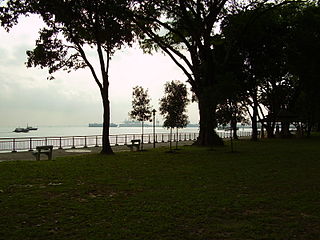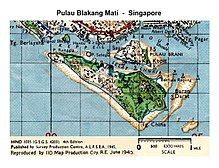
Tourism in Singapore is a major industry and contributor to the Singaporean economy. In 2019, 19,114,002 tourists visited the country, which was the highest recorded number of arrivals since independence in 1965. As of 2023, as tourist arrivals recovers from the impact of the COVID-19 pandemic, there were a total of 13,610,404 international tourists that have visited Singapore, which was more than twice the country's total population.

Fort Siloso is a decommissioned coastal artillery battery in Sentosa, Singapore. It consists of 12 such batteries which made up "Fortress Singapore" at the start of World War II, and saw action during the Battle of Singapore. The fort is now a military museum open to the public. The Surrender Chambers in Fort Siloso reopened in June 2017 with a refreshed exhibition and free admission.

The Singapore Cable Car is a gondola lift in Singapore, providing an aerial link from Mount Faber on Singapore Island to the resort island of Sentosa across the Keppel Harbour.

The Sentosa Express is a monorail line connecting Sentosa island to HarbourFront on the Singapore mainland. It was built at a cost of S$140 million to replace the previous Sentosa Monorail. Development began in June 2003 and construction works were completed in late 2006. The fully elevated 2.1-kilometre two-way line opened on 15 January 2007. The monorail system, privately owned by Sentosa Development Corporation and operated by Singapore Mass Rapid Transit, can move up to 4,000 passengers per hour per direction.

Imbiah Lookout is Singapore's biggest cluster of attractions, it is located in Sentosa Island. The area contains 11 attractions.

Sentosa Development Corporation (SDC) is a statutory board under the Ministry of Trade and Industry of the Government of Singapore.

The Sentosa Monorail was a monorail system which served as the main means of transportation on the island of Sentosa in Singapore, and has been replaced by the new monorail system, the Sentosa Express. The system was constructed at a cost of S$14 million by Von Roll of Switzerland, who also built the Singapore Cable Car.

Labrador Nature Reserve, also known locally as Labrador Park, is located in the southern part of mainland Singapore. It is home to the only rocky sea-cliff on the mainland that is accessible to the public. Since 2002, 10 hectares of coastal secondary-type vegetation and its rocky shore have been gazetted as a nature reserve and its flora and fauna preserved by NParks.

Pulau Palawan, also known as Palawan Island, is a slipper-shaped islet located just off the southwestern coast of Sentosa, south of Singapore. It lies approximately opposite Beach Station of the Sentosa Express monorail system, which is between Siloso Beach and Palawan Beach. Palawan is most likely a variant of the Malay word pahlawan, meaning "hero" or "warrior".

Resorts World Sentosa is an integrated resort on the island of Sentosa, which is located off the southern coast of Singapore. The key attractions within RWS include one of Singapore's two casinos, Universal Studios Singapore theme park the Adventure Cove Waterpark, as well as the S.E.A. Aquarium, which is the world's second largest oceanarium.

Fort Tanjong Katong, which stood from 1879 to 1901, was one of the oldest military forts built by the former British colonial government of Singapore. The fort gave its name to today's Fort Road, and it used to stand on the grounds of the present Katong Park. Fort Tanjong Katong, the only one of its kind on the eastern side of the island, was part of a series of defensive batteries and fortifications along the southern coast of Singapore, that defended the eastern approaches to the Singapore Harbour and Singapore Town against seaborne attacks. Due to its poor structural design and remoteness, the fort was subsequently abandoned and buried until its rediscovery in 2001. Found with traces of a moat and near intact perimeter wall, the fort was considered by local archaeological experts as one of Singapore's most important archaeological finds of a "true 19-century fort" to date. As a result, an archaeology group has been lobbying for the site to be gazetted as a National Monument. As of May 2010, the National Heritage Board has stated that it has no plans to gazette the fort for the time being.

Fort Pasir Panjang or Labrador Battery is located within Labrador Park at the southern tip of Singapore island. It was one of the 11 coastal artillery forts built by the British in the 19th century to defend the western passageway into Keppel Harbour against piracy and foreign naval powers. During the 1942 Battle of Pasir Panjang, the fort played a supporting role but a limited one in defending the Malay Regiments against the Japanese invasion at Bukit Chandu. In 1995, the site was gazetted by the National Heritage Board as one of the 11 World War II sites in Singapore.

Sentosa Musical Fountain, also known as the Magical Fountain of Sentosa, or as the Musical Fountain by locals, was a former musical fountain water feature and entertainment venue made by Waltzing Waters on Sentosa Island in Singapore. It was located on a now-demolished portion of the Imbiah Lookout entertainment zone on the island. The Musical Fountain was officially opened on 11 June 1982, and ceased operations 25 years later on 26 March 2007, and was demolished that same year. The venue arena could accommodate more than 5000 people. It hosted five different shows through the 25 years it had been in operation, including the famous Magical Sentosa show which ran during the last 5 years of the fountain's operations.

The Sentosa Ferry Terminal, was a cruise terminal located on the island of Sentosa, Singapore. The cruise center was the first of its kind in the region. Built by the Sentosa Development Corporation in 1972, the terminal was the first of nine planned structures to be built on Sentosa. The terminal can cater maritime traffic to various parts of Indonesia, Batam, Karimun Jawa, Tanjungbalai, Penang and Malacca. The terminal building was completed in 1987, with the now-defunct Ferry Terminal Monorail Station located within the building. After the station closed in March 2005, the station interior was kept intact, and the old monorail tracks were covered up and left forgotten. With the then-future Resorts World Sentosa about to occupy the site in 2007, the structure was subsequently demolished to make way for its new occupant.

Sentosa Fountain Gardens was a garden promenade attraction on the western part of Sentosa Island, Singapore, which opened in 1989. It was located in the Imbiah Lookout zone of the island. The gardens and other features were demolished in 2007 for construction of the new Resorts World Sentosa, a large integrated style resort with new entertainment venues.
Fort Serapong is a former coastal artillery battery on Mount Serapong hill on Sentosa Island in Singapore, then known as Pulau Blakang Mati. It was one of four major batteries on the island, along with Fort Siloso, Fort Connaught and the Mount Imbiah Battery.
Beach Station Bus Terminal is a bus terminal located in Sentosa Island, Singapore. It is located beside its namesake monorail station, Beach Station on the Sentosa Express, and under the Sentosa Express Monorail Depot, which serves as the upper floor. The terminal serves as a vital transportation node for both residents and visitors, providing access to various attractions, hotels, and residential areas on Sentosa Island.

Coastal tourism in Singapore is tourism involving, or carried out on Singapore's nearshore waters and its beaches. This includes the coast of Singapore's mainland, as well as those of its offshore islands. Coastal tourism is currently a subset of the larger tourism industry in Singapore, and encompasses the idea of the "tourist coast," referring to the coast that has been "altered or modified for the purposes of recreation and tourism," according to Singaporean geomorphologist Wong Poh Poh. It caters to both foreign visitors to Singapore, as well as locals seeking recreational activities.


































